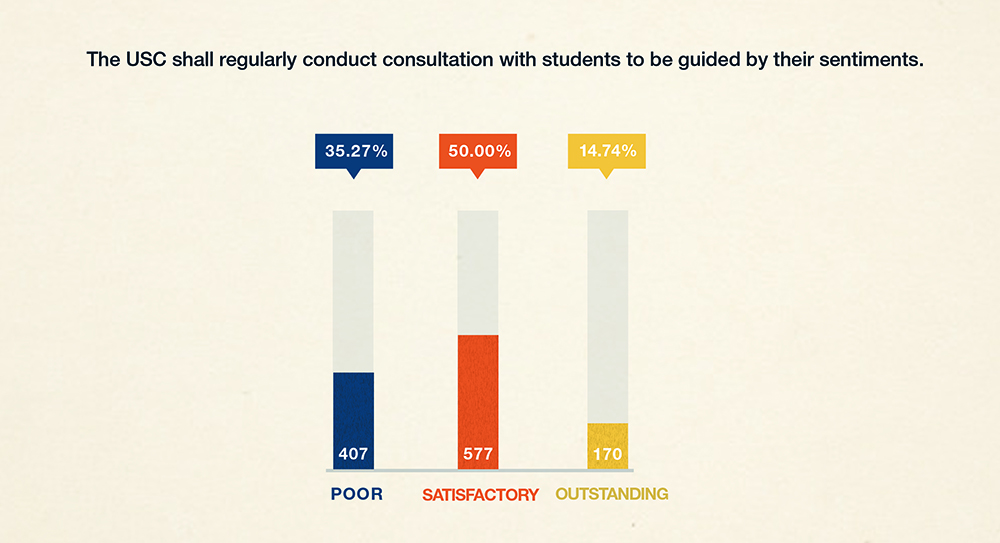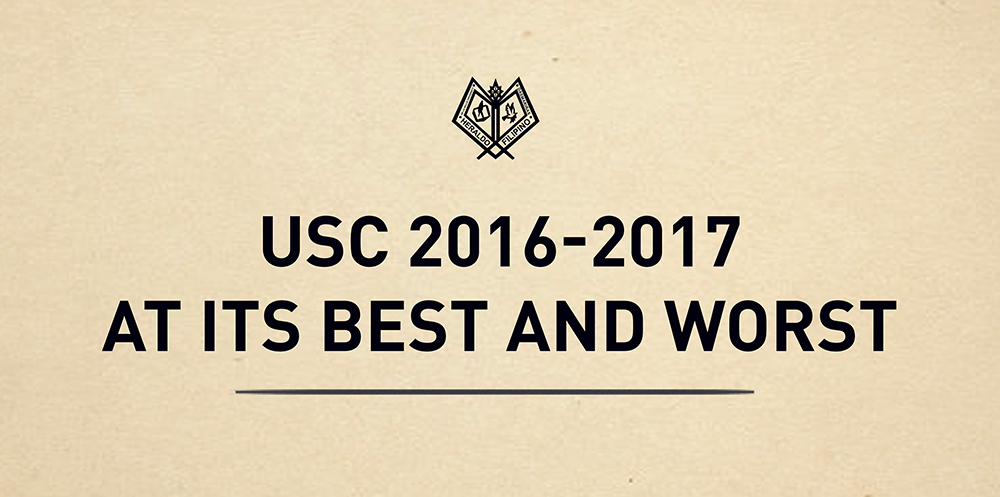USC ‘16-‘17 at its best and worst
In an interview with the Heraldo Filipino, USC shared their thoughts on their overall performance this AY. Looking at the brighter side, USC said that despite the issues they faced until the last stage of their term as student leaders, they were determined to push themselves into their finest shape––stronger and better than before.
“Bumangon. Bumangon ‘yong University Student Council (USC)” – USC 2016-2017 Public Relations Officer (PRO) Theresa Llorente
Despite the fact that most USC officers were appointed in academic year (AY) 2016-2017, it cannot be said the USC went under the radar this year. Taking the Lasallian community by storm, USC left marks filled with mixed reactions, astonishment, and uncertainty all at the same time. Facing numerous conflicts and controversies was never a piece of cake for them, however, USC 2016-2017 made sure to rise once again and finish the year, this time, complete.

Resolving disparities
Even if the USC is considered as one body, USC 2016-2017 Treasurer Mae Montehermoso said that they are still different individuals who have opposing opinions on certain issues.
Earlier this year, former USC 2016-2017 President Christine Fortunado, former USC 2016-2017 Vice President Sacen Sacay, and former USC 2016-2017 PRO Bryan Castillo officially resigned from USC on May, February, and January, respectively. Pertaining to the resignation issue, Montehermoso said, “We couldn’t let them (former USC officers) stay because we have to move on fast—because the students need us. At the end of the day, we just had to accept things.”
Putting an end to the rumors and gossips lurking around the resignations of Fortunado, Sacay, and Castillo, USC 2016-2017 brings further clarifications by sharing their thoughts on the issue that sent airwaves through the campus. USC 2016-2017 President Earll Martin Cacanindin explained that they discussed the issue together and that they had no choice but to respect and accept Sacay and Castillo’s resignations, while also requesting Fortunado to step down from USC.
However, when Montehermoso was asked what they could have done differently to prevent the resignations, she said, “Maybe things would still be the same. They would still resign because our personal interests did not sort of match.”

Appointed vs. elected
Since USC 2016-2017 was one of the first batches who had the most number of appointed USC officers than elected USC student candidates in recent history, criticisms were inevitably thrown at them—such as the quality of their performance.
In response, USC Vice President Louve Komatsu said that being appointed is not the basis to look upon and measure whether a council is effective or not. “Naniniwala naman ako na kahit sino, may potential and kaya maging isang leader. Siguro nagma-matter lang siya (on being appointed) kung paano mag–trabaho ‘yong tao. Kung paano ‘yong personality niya sa workplace.”
Supporting Komatsu’s statement, Cacanindin emphasized that as long as the person has passion for his job, he would “definitely” continue to fulfill his tasks and responsibilities despite the hardships that lie ahead.
Meanwhile, USC PROs Tania Mae Enerdecido and Llorente, and Officer in Charge (OIC) USC Secretary Romel Manalo also shared their views on the issue.
Enerdecido said that when she was offered the USC PRO position by Cacanindin, she was hesitant to accept at first due to the negative rumors she heard about USC. But soon after, she accepted the offer because she realized that it was a big opportunity to take on.
Enerdecido furthered that the chance to be a USC officer was a huge privilege which eventually became a big part of her college life. “No’ng una kasi ‘di ko talaga siya ine-expect. ‘Yong issue ng mga nag-resign is personal sa kanila (former USC officers). Parang no’ng pumasok ako, ‘di ko naman siya na-feel, na wala namang conflict talaga.”

On the other hand, Llorente initially declined the offer to be one of USC’s PRO. However, after USC Adviser Phillip Mallari encouraged and told her she had the potential to be a USC officer, she soon accepted the offer. “Sabi ni Sir Mallari, pinili ka kasi alam kong kaya mo.” When she started working at USC, she realized that USC is not just an organization, but also a family.
Through an event, USC Adviser Phillip Mallari approached Manalo who was then one of the designers. Manalo was appointed in the Visuals Committee before being assigned as the OIC Secretary. “Pumasok nako dito sa USC, I’ve seen kung ano ‘yong mga strengths and weaknesses nila (USC officers). Pansin ko talaga malaki ‘yong improvement from first sem[ester] to second sem[ester],” Manalo expressed.

On accomplishments and failures
As the AY officially ended on May 31 and their roles as USC officers will soon pass over to the next USC, Cacanindin reminisced the first days of being a USC officer as he was nearing the end of term with one word—”nangangapa“.
Comparing the past and the present, they revealed that, at first, they didn’t know the ins and outs of events management like they do now. Meanwhile, Komatsu described USC as “complicated,” noting that the job was rough at first, but they’ve managed to keep up with the race despite the conflicts they faced in the past semester.
Despite their achievements, Cacanindin admitted that even though other USC batches “had one or two [officer] resignations”, their “greatest failure” was the number of resignations in their term.
“Natapos ang taon, we’re known as the council with greatest number of resignations …Well, ayaw namin na doon lang kami makilala. ‘Yong attitude namin dati [wherein] ‘yong bitterness is there …kung ano man kami dati, ‘di na kami ‘yon ngayon,” Montehermoso stressed.
Meanwhile, Komatsu shared about their plan, the “hard project”, for they do not want to be remembered by the students as the council who only conducted extravagant events and concerts. Cacanindin disclosed that the “hard project” was supposed to be a plan providing the students a “study area” in the University. However, due to lack of time to carry out the said project, Cacanindin said that they plan to suggest the “hard project” to the incoming USC officers during their turnover on June 30.

For the next USC
As their turnover approaches in just a few days on June 30, USC 2016-2017 officers gave their own advice and messages to their successors.
Cacanindin started with “Alamin nila sa sarili nila na ‘yong pinasok nila, gusto talaga nila ‘yong ginagawa [kasi] ‘yong hirap na pagme-maintain-in mo ‘yong council tsaka ‘yong academics is hindi talaga ganoon kadali.”
Montehermoso said they should consider the possible conflict of USC officers “not being able to meet halfway” due to some USC officers being “absolute,” leaving them with no choice but to agree.
In completing the designated tasks given to each USC officer, Komatsu advised the next USC officers to take initiative in assuming the duties of a co-officer if they are aware that the task has not yet been done. “Sasabihin nila (USC 2017-2018 officers) na ‘Ay ayoko kasing ma-bypass, ayoko kasing magbida–bida.’ Sana tanggalin rin nila sa kanila ‘yon kasi walang mangyayari kung mahihiya sila. Kaya nga sila nandito sa council kasi pinagkatiwalaan sila, so sana ‘wag nilang sayangin.”

Sticks and stones
In one way or another, receiving criticisms, rants, or even tirades are inevitable in a council, especially when it is considered the highest governing student body of the University.
Undoubtedly, this AY has been the one of the most difficult and controversial years for USC. From the resignations of some USC officers to filling vacant positions left in USC, it became one of the darkest times in their term.
Even with the last few weeks of USC 2016-2017’s term, they were still challenged to defend the pleas and rights of the students when a change of schedule was made for this AY’s Graduation Day which affected the students and parents, particularly the Overseas Filipino Workers. Some complained and even put the blame on USC. Nevertheless, as seen on their official Facebook post, the USC replied to almost every student, parent, and even non-Lasallian, providing explanations and apologies for the sudden announcement of the administration.
In response to the criticisms regarding USC’s performance this AY, Cacanindin said that despite their shortcomings as a council, he could say that they have tried to place things back together this past semester.
“Wala kasing perfect na organization e. ‘Di naman namin mapi-please lahat na parang magustuhan kung paano ‘yung performance namin. Kung sa tingin nila (next USC officers) may mga nagawa kaming ‘di maganda, matuto na sila doon and sa pagpasok ng term nila is i-make sure nila na ‘di mauulit ‘yon (different problems and issues encountered by USC 2016-2017).”
But when asked what the USC officers can advise to their former selves, Montehermoso replied, “Stop studying.”
She explained, “Kasi a lot of people helped and I felt my professors adjusted to my situation and they were happy that I am in the council. I felt their support and I felt more matured na I was able to balance it out. I should have taken a break first from my study but not to the point na nagkabagsak ako or anything.”
On the other hand, Cacanindin said that he learned how to handle stress more, especially in balancing council duties with academic requirements.
Meanwhile, addressing DLSU-D students, Llorente said that as part of the USC, every student has the potential to lead even if one comes from a lower-level organization or program council. She furthered that they wanted to show the students that they can be leaders as well. “Gusto naming ipakita or iparamdam sa mga estudyante na kung ano man ‘yong ginagawa ng iba, kaya mo din,” Llorente expressed.

Performance evaluation
In line with the end-of-the-term interview with USC 2016-2017, the Heraldo Filipino conducted its annual USC Performance Evaluation this AY 2016-2017 from May 12 to 29, 2017 with a total of 1,154 respondents from DLSU-D undergraduate students across all years. The survey’s items are based off of the council’s responsibilities as stated in the 2014-2018 DLSU-D Student Handbook.
The seven responsibilities as stipulated in the handbook are as follows: shall serve as a mediator between the student body and any sector of the Lasallian community in case of differences; together with the student groups, shall be an active agent in promoting national awareness and consciousness among DLSU-D students; shall foster an atmosphere where critical thinking prevails; shall protect the rights and welfare of the students at all times; together with the student groups, shall enjoin the students to act as one in advancing their rights and welfare; shall regularly conduct consultation with students to be guided by their sentiments; and shall promote the Lasallian identity of spirit of faith, zeal for service, and communion mission.
Respondents were given three options in evaluating USC’s performance in one of the mentioned responsibilities: poor, satisfactory, and outstanding. The results can be viewed in the seven graphs throughout this article.
The results showed that majority of the students rated USC 2016-2017 officers’ performance as satisfactory in all seven responsibilities, similar to the results of last year’s USC (2015-2016) performance evaluation. However, after the rating of ‘satisfactory’, USC 2016-2017’s second highest rating was ‘poor’ for all questions, followed by ‘outstanding’ as the least rated. The rating of ‘outstanding’ did not surpass ‘poor’ in any of the questions. This is in contrast to USC 2015-2016’s survey results in which ‘outstanding’ was the second overall highest rating, with ‘poor’ as the least rated.
The responsibility that USC 2016-2017 was evaluated as the most effective in was that of “mediator between the student body and any sectors Lasallian community,” with an overall ‘satisfactory’ rate of 58.06%. On the other hand, the students evaluated that they were least effective in the responsibility to “regularly conduct consultation with students to be guided by their sentiments,” which received their highest ‘poor’ rating at 35.27%. Meanwhile, their highest rating of ‘outstanding’ was 20.02% in their role to “promote the Lasallian identity of spirit of faith, zeal for service, and communion mission.”
Overall, despite the issues that circulated USC this year, it didn’t deter them from serving the students at overall ‘satisfactory’ standards, as rated by the students themselves. Yet as Lasallians whose values are ingrained with service, perhaps the next student leaders ought to aim not just for ‘satisfactory’ service, but ‘outstanding.’




